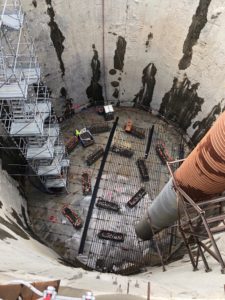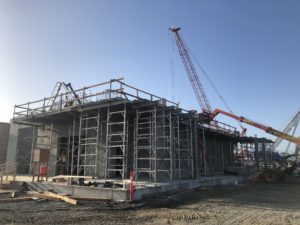Design for the Front of Plant (FoP) project is on track, with the 100% design package being completed this month. The design package describes all equipment, facilities, and structures that will be constructed and installed over the subsequent months. Construction in progress at the FoP is on target with completion of 17 of the 29 wall panels and preparation to place the second level deck slab of the Headworks structure. Inside the vertical shaft that will house the Receiving Lift Station (RLS), work is ongoing to install reinforcing steel bars (referred to as rebar) for the concrete base slab that will support the lift pumps and related piping. The base slab will be poured in early 2020. To ensure safe working conditions, stairway access and a working platform is installed at the shaft to provide safe and easy access for the construction crews. SVCW places a high priority on the safety of our teams (both our full-time onsite staff and our construction partners) and we place our stakeholders first and construction schedule second. Safety is everyone’s responsibility on the RESCU Program, and safe work practices are discussed by the Program teams daily at the start of every construction activity and at the beginning of every team meeting.
SVCW has chosen Progressive Design Build (PDB) for project delivery, and we have insisted that each of our construction partners locate their key staff onsite at our RESCU center with our SVCW team members to ensure the greatest opportunities for collaboration as early as possible during design and construction. Collaboration and coordination are essential for the RESCU projects to fit together both in the field and when commissioned for operations. With support from SVCW’s team of design and construction advisors, the different project teams engage regularly in coordinating elements of their respective projects to support the other projects at their connection points. Specifically, this month, teams been monitoring soil conditions in the Surge and Flow Splitter (SFS) shaft (the vertical shaft located immediately before the RLS which will provide flow protection during wet weather events) as the soil inside the excavation support panels is removed. The SFS shaft has been excavated this month to a depth of approximately 60 feet below ground surface, with a final target depth of 90 feet. At 60 feet depth, the design team for the Gravity Pipeline (GP) project has come to the FoP site this month to observe and sample the soil between 60 feet and 75 feet below grade; this depth range constitutes the tunneling zone where Salus, the Tunnel Boring Machine (TBM), will break into the SFS shaft at the completion of the second of the two tunnel drives planned for the GP project. The two project teams are also coordinating over the concrete strength in the portion of the SFS shaft wall where Salus will break through. SVCW has found direct and regular coordination among project teams yields the highest quality and most cost-effective solutions.

